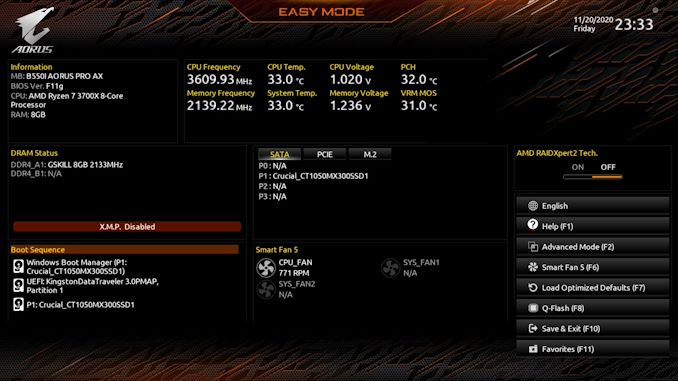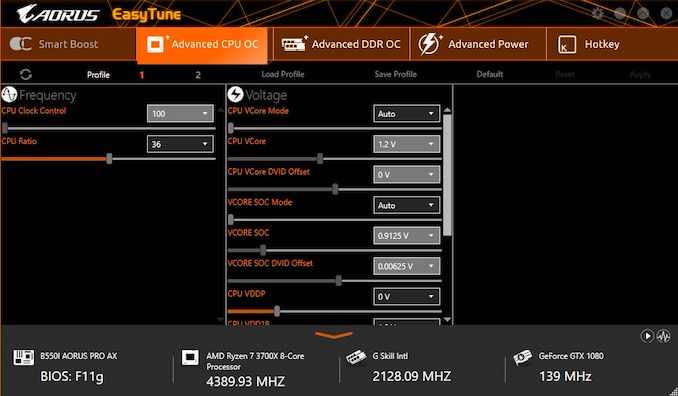The GIGABYTE B550I Aorus Pro AX Motherboard Review: All The Small Things
by Gavin Bonshor on December 7, 2020 10:00 AM ESTBIOS
Unspringsingly, GIGABYTE's B550 firmware is practically identical to its X570 models, as we've seen previously in our GIGABYTE X570 I Aorus Pro WIFI review. The GIGABYTE UEFI firmware for its AMD 500 series Aorus branded models follows a distinct black and orange theme, with white text and orange highlighting. Looking at the BIOS layout, GIGABYTE has split the firmware into two modes, easy mode for the beginner and advanced for the more experienced user.
Focusing on the Easy mode screen, which is the default screen when POSTing for the first time, displays basic yet relevant information about hardware installed. Towards the top is a list of information, including the motherboard model, the BIOS version (F11g for our test), and the processor and amount of memory installed. Users can select between the different types of devices to check if the hardware is installed correctly, including SATA, PCIe, and M.2 devices, as well as a basic list of Smart 5 fan details for the board's three 4-pin fan headers. Along the right-hand side, users can select between different functions, including the advanced mode by pressing the F2 key, load up the Smart Fan 5 tuning utility by pressing F6, and the board's integrated Q-Flash utility for updating the board's firmware by pressing the F8 key.
The rest of the board's firmware focuses on the Advanced mode, which can be done by pressing the F2 key. This allows users to select between various BIOS functions, including the Tweaker sections where all of the board's CPU, memory, and integrated graphics overclocking can be done. Users can adjust CPU frequency, the base clock (BCLK), CPU VCore, among many other voltage settings, including CPU VDDP and DRAM termination voltages. This is also where users can enable XMP profiles at the click of a button or customize memory profiles further for performance tweakers. It should be noted the sweet spot for Ryzen 3000 processors is DDR4-3600, with an Infinity Fabric clock speed of 1800 MHz.
Overall, GIGABYTE's Aorus UEFI firmware keeps things simple with the basic mode, with a basic looking, but the bountiful and endless list of configurable variables, most of which can be found in the Tweaker section. The firmware itself is responsive and offers users from both the novice and advanced spectrums plenty of options to work with.
Software
All of the major motherboard vendors have equally impressive software packages, with various functions to use all of the boards primarily features. GIGABYTE includes plenty with the B550I Aorus Pro AX model, including the EasyTune software designed to allow users to overclock within Windows, the RGB Fusion 2.0 software to control the board's RGB capabilities, and the System Information Viewer (SIV). The SIV software allows users to access the Smart Fan 5 utility within Windows and allows for system alerts for over-voltage and various temperatures.
The most prominent piece of software bundled with the GIGABYTE is the Aorus Easy Tune software. This allows users to overclock the memory and CPU within Windows, with plenty of voltage options and important CPU ratio and memory ratio settings. We still recommend all of the overclocking is done within the BIOS, but overclocking software has come a long way over the last decade, and Easy Tune is quite intuitive.
Unfortunately, GIGABYTE doesn't include any audio software within the bundle, and users looking to make customizations will need to download the Realtek Control Panel directly from the Microsoft Store. Focusing on what is actually there, the bundle offers plenty of customizability. This includes the Fusion 2.0 RGB software for those adding additional RGB LED strips and the Realtek Gaming LAN manager for traffic shaping when used with the RTL8125 2.5 GbE port on the rear panel. It's not the most comprehensive software suite we've seen over the years, but it's more than enough for a sub $200 model aiming at the mid-range.
























76 Comments
View All Comments
quorm - Monday, December 7, 2020 - link
What is the massive AMD AM4 keep out area?Slash3 - Monday, December 7, 2020 - link
The space around the CPU socket required for mounting clearance is probably what they're referring to. On that note, the Asrock AM4 mITX actually use Intel LGA11XX mount spacing for this reason.meacupla - Tuesday, December 8, 2020 - link
The AM4 keepout area is a good thing though. Especially when the mobo adheres with the steel backplate.There are plenty of LGA11XX mITX boards that completely ignore the back side of the MOBO and run into issues with aftermarket CPU coolers that require backplates.
Allan_Hundeboll - Thursday, December 17, 2020 - link
I "upgraded" from ab350 fata1ity to the b550i Aorus pro because I wanted a board that would support ryzen 5000. I also hoped the better vrm would make it possible to oc my water-cooled 3700x a little higher.But the the b550I seems to hate my 2x16GB micron rev E memory. So I just can't make 1900Mhz IF/3800Mhz MEM stable like it did on the cheap ab350.
The strong VRM didn't oc my 3700x any better, but I discovered that low PBO power draw values (like 5W) makes. PBO boost like crazy, when disabling C3 sleep. So my cpu benchmarks gained a little performance.
So you made a smart decision holding on to that ab350!
Mr Perfect - Monday, December 7, 2020 - link
The lack of USB ports is odd, especially when they included three video ports that a majority of people will never use. If AMD CPUs had built in video ports, then sure, throw in a whole bunch of graphics ports, but a gaming board isn't likely to get an APU installed.calc76 - Monday, December 7, 2020 - link
The B550 chipset is the limiting factor with USB 3 ports. The B550 isn't really in the same class chipset as a Z490. The B550 supports more ports than are in some of the mini-ITX boards but ones like the ASUS B550-I support nearly all but some of the extra USB 2.0 ports.mkarwin - Tuesday, December 15, 2020 - link
Even with USB3 count restriction, there are still USB2 options - most printers/keyboards/mice/scanners won't need the gen 3 speeds so adding a quartet of additional rear I/O placed USB2 ports wouldn't break the bank whilst giving a lot more connectivity that people could actually use... Though at the same time, X570 boards from the same product family are not fairing any better whilst being "top of the line AM4 chipsets" sporting. Somehow the ATX size allows adding more ports to the rear I/O, but already mATX suffers nearly the same as mITX. I'm not sure if those ATX offerings come with additional USB controllers on board that just can't fit on ITX boards or maybe it's merely manufacturers way to skimp $1 on a set of connectors on the back and treat it as an excude for no additonal signaling work through the PCB whilst still asking higher prices for the premium smaller market...Luminar - Monday, December 7, 2020 - link
Just what we need instead of a 6800 review lolGolgatha777 - Monday, December 7, 2020 - link
True, you can actually buy this.vanilla_gorilla - Monday, December 7, 2020 - link
This is exactly what I need. I'm currently using an X570 I Aorus Wi-Fi mini-itx board in a SFF case. The problem is I cannot find any AM4 Mini-iTX boards with multi-gig or 10GbE LoM. I'm really disappointed we don't see more multi and 10Gb boards. I just got an email last week that Google Fiber now offers 2Gb/s service here in Nashville. I was looking at USB based multi-gig adapters but I'd much rather have it on the motherboard, of course.